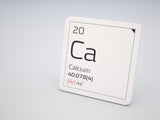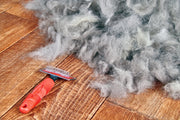Does Your Dog Deserve Cancer?
Your reaction upon reading the title of this article was probably something along the lines of “Of course not!” But did you know that various synthetic dyes have been linked to cancers? And, in Australia, pet food manufacturers are under no obligation to reveal what, exactly, is included under the category colouring.
Food Dyes Linked to Cancer and Other Health Risks
What is well documented are the dangers of certain artificial colours added to both animal and human foods. Red Dye No. 3 has been linked to cancers, Yellow No. 5 to allergic reactions, and Blue Dye No. 1 with neurotoxicity. One wonders why, when there are grave concerns about these dyes, why they are added in the first place as they offer no nutritional benefits whatsoever. While the amounts an average person might consume are considered not to be harmful, consider that a dog or cat fed a commercial kibble will eat the same food day in and day out, potentially for years. That’s a recipe for potential disaster!
Reading Labels in Australia Only Helps So Much
With that in mind, have a look at the labels on the commercial dog foods next time you are at the supermarket. Colouring? Ok. But what type and how much? Who knows? And then ask yourself, does your dog deserve cancer? Or, does your canine companion deserve better? Food dyes are used in commercial dog foods and, sadly, though the price may be tempting, there’s a reason why we use the saying, cheap and nasty.
Our Dogs Depend on Us
Sometimes, we all need to cut corners, but to my way of thinking we shouldn’t make our dogs pay the price. At Rawmate, we can be pretty picky sometimes about who we bring on-board. We are building the future and if you aren't 100% committed to doing the absolute best by your dog, then we wish you luck and urge you to find a solution within your price range (without paint, colouring, meal, by-products, cereals or grains).
Any Colouring in Rawmate Prepared Meals?
Hell no! You might notice the sheer list of ingredients in Rawmate formulations. We operate on the principle of "as little supplementation as possible”. This is one of our guiding mantras. If it takes 25 ingredients to find the right balance naturally, then so be it. You won't find any powders, meal, by-product, grain, cereals, colours or paint in any of our AAFCO Complete and Balanced meal plan solutions. Ever!
Who Knows What’s in that Bowl of Kibble
We've discussed it here before on the Rawmate blog, in Australia we are in a period of non-regulation when it comes to the creation, manufacture and distribution of Pet Foods. A nutritional panel on a bag of "Australian Made Kibble" might say colouring, but what combinations of colours listed in the table below do you think that might include? Who knows?
|
Additive |
Function |
Natural or Synthetic |
Year Banned |
Problem |
|
Agene (nitrogen trichloride) |
flour bleaching and aging agent |
synthetic |
1949 |
Dogs that ate bread made from treated flour suffered epileptic-like fits; the toxic agent was methionine sulfoxime. |
|
Artificial Colorings: |
|
|
|
|
|
Butter yellow |
artificial coloring |
synthetic |
1919 |
Toxic, later found to cause liver cancer. |
|
Green 1 |
artificial coloring |
synthetic |
1965 |
Liver cancer |
|
Green 2 |
artificial coloring |
synthetic |
1965 |
Insufficient economic importance to be tested |
|
Orange 1 |
artificial coloring |
synthetic |
1956 |
Organ damage |
|
Orange 2 |
artificial coloring |
synthetic |
1960 |
Organ damage |
|
Orange B |
artificial coloring |
synthetic |
1978 (ban never finalized) |
Contained low levels of a cancer-causing contaminant. Orange B was used only in sausage casings to color sausages, but is no longer used in the United States. |
|
Red 1 |
artificial coloring |
synthetic |
1961 |
Liver cancer |
|
Red 2 |
artificial coloring |
synthetic |
1976 |
Possible carcinogen |
|
Red 4 |
artificial coloring |
synthetic |
1976 |
High levels damaged adrenal cortex of dog; after 1965 it was used only in maraschino cherries and certain pills; it is still allowed in externally applied drugs and cosmetics. |
|
Red 32 |
artificial coloring |
synthetic |
1956 |
Damages internal organs and may be a weak carcinogen; since 1956 it continues to be used under the name Citrus Red 2 only to color oranges (2 ppm). |
|
Sudan 1 |
artificial coloring |
synthetic |
1919 |
Toxic, later found to be carcinogenic. |
|
Violet 1 |
artificial coloring |
synthetic |
1973 |
Cancer (it had been used to stamp the Department of Agriculture’s inspection mark on beef carcasses). |
|
Yellow 1 & 2 |
artificial coloring |
synthetic |
1959 |
Intestinal lesions at high dosages. |
|
Yellow 3 |
artificial coloring |
synthetic |
1959 |
Heart damage at high dosages. |
|
Yellow 4 |
artificial coloring |
synthetic |
1959 |
Heart damage at high dosages. |
|
Other Additives: |
|
|
|
|
|
cinnamyl anthranilate |
artificial flavoring |
synthetic |
1982 |
Liver cancer |
|
cobalt salts |
stabilize beer foam |
synthetic |
1966 |
Toxic effects on heart |
|
coumarin |
flavoring |
tonka bean |
1970 |
Liver poison |
|
cyclamate |
artificial sweetener |
synthetic |
1969 |
Bladder cancer, damage to testes; now not thought to cause cancer directly, but to increase the potency of other carcinogens. |
|
diethyl pyrocarbonate (DEPC) |
preservative (beverages) |
synthetic |
1972 |
Combines with ammonia to form urethane, a carcinogen |
|
dulcin (p-ethoxy-phenylurea) |
artificial sweetener |
synthetic |
1950 |
Liver cancer |
|
ethylene glycol |
solvent |
synthetic |
1998 |
Kidney damage |
|
monochloroacetic acid |
preservative |
synthetic |
1941 |
Highly toxic |
|
nordihydroguaiaretic acid (NDGA) |
antioxidant |
desert plant |
1968 (FDA), 1971 (USDA) |
Kidney damage |
|
oil of calamus |
flavoring |
root of calamus |
1968 |
Intestinal cancer |
|
polyoxyethylene-8-stearate (Myrj 45) |
emulsifier |
synthetic |
1952 |
High levels caused bladder stones and tumors |
|
safrole |
flavoring (root beer) |
sassafras |
1960 |
Liver cancer |
|
thiourea |
preservative |
synthetic |
c. 1950 |
Liver cancer |
Compare our wild west attitude of pet food production to what you see in the United States, where relations require manufacturers to clearly state exactly what colouring means, and you can see we have a problem. I won’t rant about this again here, but seriously, why do regulators here not think our animal companions are worth protecting?
Welcome, and Thank You!
I did want to give all of you readers a shout out. I know that you are here and reading this blog because you DO care about your dogs and for that I am deeply grateful. It can feel a bit lonely standing up here on my soapbox sometimes!
If you’ve just stumbled on this blog, then welcome. Maybe you found your way here because you are looking for real, whole, healthy food for your dog. Well, you’ve found it! Healthier Dog Food Delivered! That's us.
As for that informative table above, it’s from the Centre for Science in the Public Interest. The website has lots of great information if you are looking for science-backed research about healthy foods. Yes, it’s wonderful that you are feeding your dogs well, that’s as it should be, but there’s lots to be learned about the toxins, additives, and failings of the human food supply as well.







There are 0 Comments